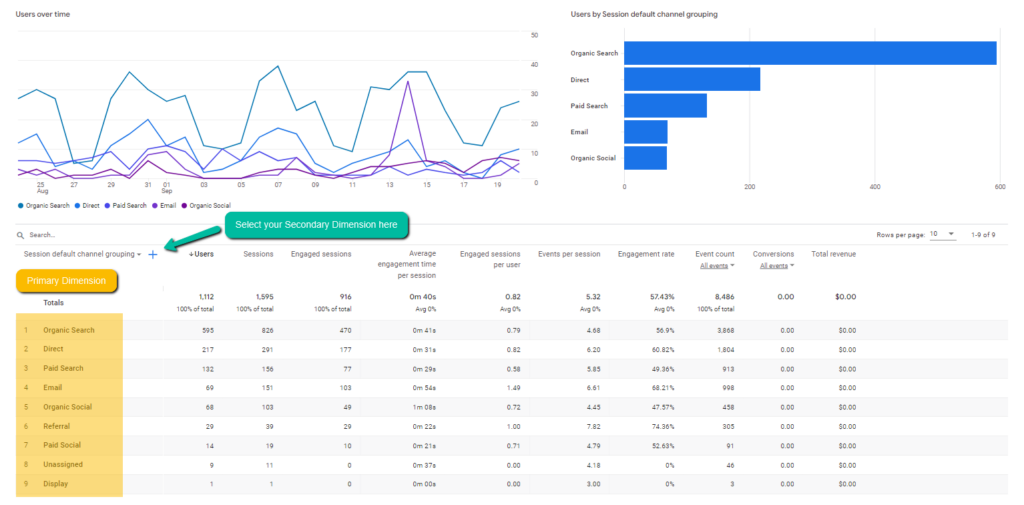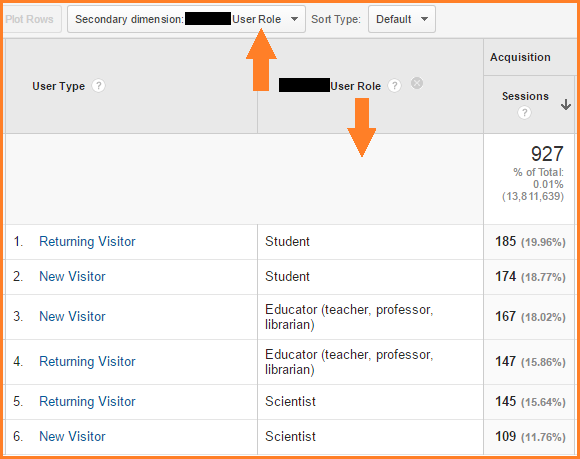Transform Your Analytics Method With Secondary Measurement in Google Analytics
By integrating second dimensions into information analysis, a brand-new layer of insights arises, dropping light on intricate customer habits and communications. The calculated application of secondary measurements holds the essential to opening a treasure trove of important details that can transform exactly how businesses act and interpret upon their data.
Recognizing Secondary Measurements in Google Analytics
Second dimensions in Google Analytics give additional context to main information by allowing individuals to assess metrics across a 2nd measurement, providing much deeper insights into individual habits and communications on a website. Secondary Dimension in Google Analytics. While main measurements provide essential information points such as pageviews, bounce rate, and session period, secondary dimensions use an even more comprehensive sight by segmenting the key data further. This division allows users to examine metrics in mix with an additional measurement, such as traffic resources, demographics, or customer behavior
Benefits of Using Secondary Dimensions
Utilizing secondary dimensions in Google Analytics provides a calculated benefit by improving the deepness of analysis and supplying a much more detailed understanding of customer interactions and actions on a site. By incorporating secondary measurements, experts can get beneficial understandings into the performance of specific sectors or variables within their information. This makes it possible for a much more in-depth exam of user habits beyond surface-level metrics, enabling a much deeper expedition of the elements influencing customer involvement and conversions.

How to Implement Second Measurements
When integrating secondary dimensions in Google Analytics, one essential action is to select the appropriate metrics and measurements to enrich the analysis procedure. To execute second dimensions successfully, start by accessing your Google Analytics account and navigating to the record you intend to improve with added data. When in the report, locate the "Additional Measurement" button, usually found above the data table. Clicking on this switch will certainly open up a drop-down menu listing different measurements that can be added to your main measurement for much deeper insights.
After selecting the appropriate additional measurement, such as 'Source/Medium' or 'Tool Group,' Google Analytics will display the data in an extra thorough style, enabling you to cross-analyze various facets of individual habits. Bear in mind to trying out different combinations of primary and additional dimensions to discover important patterns and patterns that can notify your advertising approaches. By applying secondary dimensions thoughtfully, you can get a much more detailed understanding of your link web site or application performance and make data-driven decisions to enhance your digital presence.
Analyzing Data With Secondary Dimensions
Boost your data analysis in Google Analytics by incorporating second measurements to dig deeper right into individual behavior patterns and maximize your digital marketing strategies effectively - Secondary Dimension in Google Analytics. By including secondary measurements to your main information, you can acquire valuable understandings that can help you make educated decisions concerning your web site or app efficiency
Analyzing information with additional measurements enables you to segment your main information additionally, offering an extra extensive sight of individual communications. As an example, combining the key dimension of 'source/medium' with a second dimension like 'touchdown page' can expose which specific pages are driving traffic from different resources. This details can be critical in improving your content method or maximizing your advertising and marketing campaigns to enhance conversions.
In addition, utilizing additional measurements enables you to determine relationships between different metrics, assisting you comprehend the influence of various elements on individual habits. Whether it's analyzing demographics along with user engagement metrics or device classifications with conversion rates, additional measurements encourage you to uncover covert patterns and patterns that can assist your advertising initiatives.
Maximizing Efficiency With Second Measurements
To improve the effectiveness of data analysis and decision-making in Google Analytics, integrating additional measurements is vital to enhancing efficiency metrics and obtaining deeper insights right into customer actions patterns. By making use of secondary dimensions, experts can delve past surface-level data and reveal valuable relationships that might or else go undetected. This optimization method enables companies to customize their advertising efforts more effectively, recognize locations for enhancement in website use, and boost general user experience.
Second dimensions supply an even more detailed view of individual interactions by providing added context to key information metrics. Combining the primary measurement of 'landing web page' with you can try here an additional measurement like 'gadget classification' can reveal whether certain tools are much more most likely to drive interaction on details landing web pages. This insight can notify responsive style improvements or targeted advertising and marketing approaches to increase efficiency.

Conclusion
To conclude, the assimilation of second dimensions in Google Analytics gives organizations with an effective tool to boost their analytics technique. Secondary Dimension in Google Analytics. By diving deeper into customer habits and interactions, marketing experts can discover valuable insights that can drive efficiency optimization and enhance the overall customer experience. Leveraging secondary measurements enables Click This Link a much more comprehensive evaluation of information, causing more enlightened decision-making and tailored marketing initiatives
Additional measurements in Google Analytics supply added context to main information by enabling customers to evaluate metrics throughout a 2nd measurement, providing deeper understandings right into user actions and communications on a website. While key dimensions give fundamental data points such as pageviews, bounce price, and session period, secondary dimensions use a more thorough sight by segmenting the main information better.One of the essential benefits of making use of second dimensions is the capability to reveal correlations and patterns that may not be instantly evident when assessing data with primary dimensions alone.When incorporating additional measurements in Google Analytics, one crucial step is to select the appropriate metrics and dimensions to enhance the evaluation procedure. Matching the main measurement of 'touchdown web page' with a second measurement like 'tool category' can reveal whether certain gadgets are extra most likely to drive engagement on certain landing web pages.